
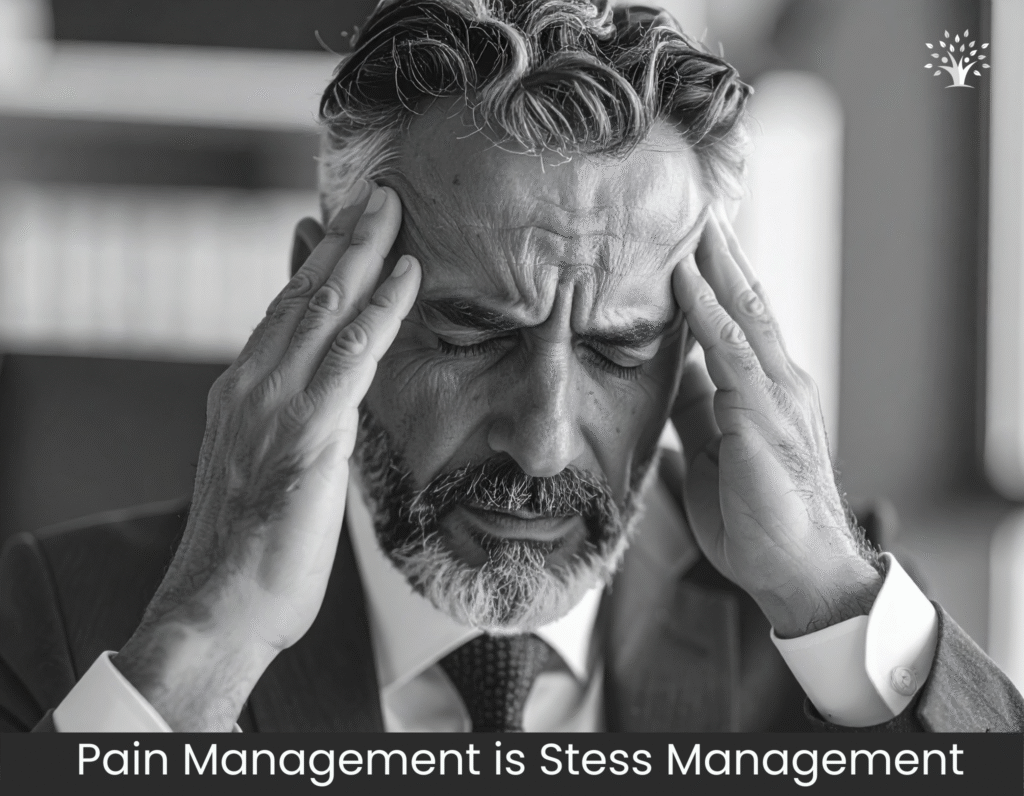
Pain Management Is Stress Management: My Awakening
Functional Health and Wellness by Samuel
Introduction: Pain and Stress Management
There’s nothing more isolating than chronic pain and feeling like no one understands,not even your own body. When stress builds on top of it, the cycle feels impossible to break. That’s why pain management is stress management. You’re exhausted. You can’t sleep. You can’t move. And worst of all—you start to lose hope.
Jump to a Section:
The hardest part of recovering from injury isn’t always physical. For me, it was the emotional and mental toll that came with relentless pain. I was a workaholic jet setter who lived life on maximum effort—24/7. I woke up early, stayed productive, and pushed through every day with intensity. That version of me was forced to stop the moment injury struck.
Suddenly, I couldn’t walk. I couldn’t sleep without medication. I couldn’t function without pain. It wasn’t just the physical limitations—it was the overwhelming sense of helplessness that came from the pain. Nobody is ever really prepared for this kind of crash.
The lowest point came during a long, sweltering Fourth of July weekend. The pain was intense—so sharp I couldn’t sleep or move without crying out. I remember lying in the dark, wondering, “Am I going to walk again? Is this my new reality? Am I broken?”
That night, I whispered to myself, “God, help me. If you get me through this, I’ll do something good for this world and give it back.” That promise became a personal anchor to start this blog with Mijung—to share what we’ve learned and support others who feel stuck in the same dark place.
This post tells the full story—how stress made my pain worse, how mindset became my medicine, and the exact tools that helped me begin to heal. Pain management is stress management—and learning that truth changed everything for me.
If you’re dealing with this right now, know this: you’re not alone, and you’re not broken. I hope my story gives you something practical to hold onto—and a push to take your own first step forward. You deserve relief, and it’s possible.
If anything here resonates, know that this isn’t just about me. This is about all of us who are living with pain. The tools I share are here for you. Start small. Start where you are.
National Institute of Mental Health: So Stressed Out — Fact Sheet
I. When Pain and Stress Create a Vicious Cycle
Want to read more on this? Explore expert-backed articles that support the idea that pain management is stress management:
-
SEPA Pain & Spine: How Stress and Anxiety Contribute to Pain– Cleveland Clinic: Chronic Stress Puts Your Health at Risk
These experts break down how emotional stress affects your nervous system, triggers inflammation, and worsens pain conditions.
Pain management and stress management are closely linked because stress can significantly worsen the experience of pain, and managing stress can lead to a reduction in pain perception. Chronic pain can, in turn, be a major source of stress, creating a vicious cycle. By addressing both the physical pain and the associated stress, individuals can experience more comprehensive relief and improved overall well-being. This further drives the point that pain management is stress management.
Pain creates stress. Stress increases pain. This loop is well-documented in medical literature. When you’re injured or in chronic pain, your body is flooded with stress hormones like cortisol and adrenaline. These chemicals tighten muscles, increase inflammation, disrupt sleep, and reduce your body’s ability to heal.
A 2017 article in Pain Reports *notes: “Stress not only exacerbates existing pain conditions, but prolonged pain can itself become a chronic stressor… impacting the HPA axis, leading to elevated cortisol, sleep disruption, and reduced healing capacity.” *Read full article
The longer you’re caught in this cycle, the harder it is to break. I learned that no medication or surgery could truly work until I addressed the emotional weight I was carrying.
If you’re reading this and nodding—keep going. The pain may feel permanent, but recovery is already in motion when you decide to take back control.
II. Why Pain Management Matters
Want to go deeper? Here are more respected sources that expand on how pain and stress are connected:
These insights reinforce the importance of managing emotional health as a foundation for lasting relief from chronic pain.
Pain management is important not just for comfort—it’s critical for recovery. Effective pain control can:
-
Improve your overall quality of life
-
Prevent secondary complications like sleep disorders, depression, and physical deconditioning
-
Help expedite recovery by promoting movement, reducing inflammation, and enabling better focus and rest
When pain is controlled, your body and mind can begin the work of true healing. Addressing stress and pain together creates a sustainable foundation for long-term recovery—not just from injury, but from the emotional toll it takes. Pain management is stress management in every way that matters.
You don’t need a miracle. You need a plan. And it starts with calming your body and taking the pressure off your mind.
III. My Turning Point: Psychiatric and Psychological Support
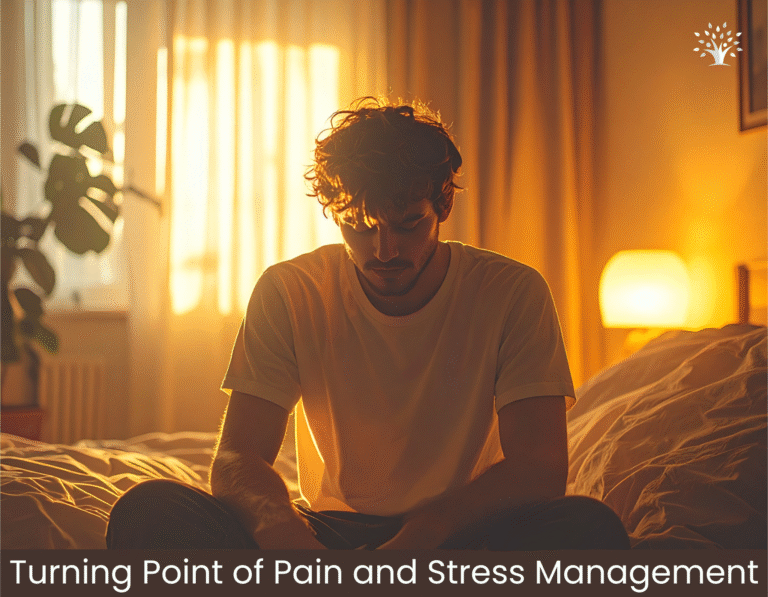
After another pain flare-up that lasted 7 days, I was physically exhausted and mentally breaking down. That’s when I sought professional help. I met with both psychiatric and psychological professionals who listened and gave simple, life-changing advice:
-
You need to slow down
-
You need to breathe
-
You need to accept that healing takes time
These may sound simple, but for someone like me—always on the go, obsessed with progress—it was a major mental shift. Once I accepted that slowing down was a part of recovery, my stress levels dropped and my body responded.
Those early changes laid the groundwork for the daily habits that would soon become my personal recovery system. Pain management is stress management—and that starts in your mind
IV. Steps 1–4: Daily Tools That Calm My Body
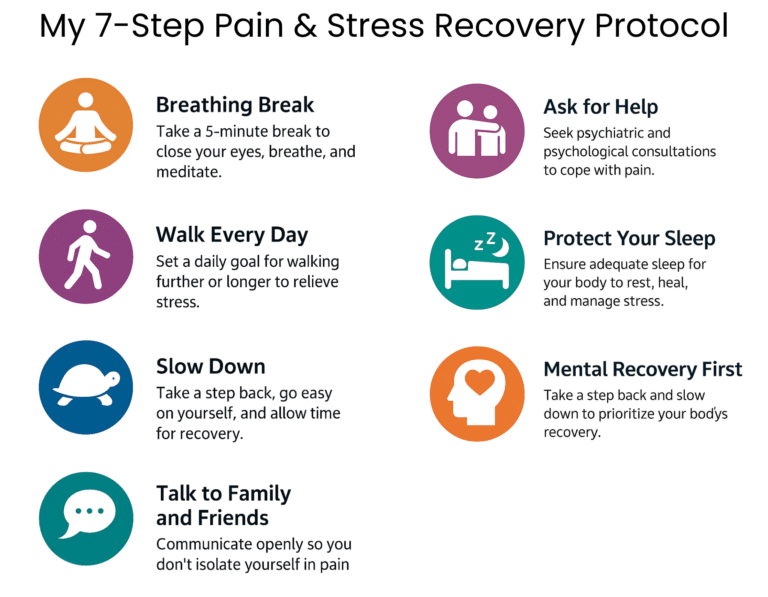
Part of My 7-Step Pain & Stress Recovery Protocol
Want supporting evidence? These 7 steps are aligned with research-backed strategies from trusted medical sources:
-
ScienceDirect: Mindfulness Meditation for Chronic Pain – A Meta-Analysis
-
NIH: Chronic Pain and Complementary Health Approaches – Usefulness and Safety
These resources support the power of mindfulness, movement, communication, sleep, and asking for help—exactly the foundation of what follows.
This routine came from personal experience—not research, not theory. It was built through pain, setbacks, small wins, and one promise: If I recover, I will help others do the same. That’s why Mijung and I built this blog. These seven points are what kept me moving through the hardest days.
-
Breathing Breaks
Under pressure, in pain, or overwhelmed, I learned to pause. I’d close my eyes, breathe in… breathe out… and give myself a moment of peace. No phone. No TV. Just stillness. This simple act helped me break cycles of anxiety and tension. It reminded me that pain management is stress management, even in small moments.
If you need help getting started, I recommend the Insight Timer app. It’s free and offers guided breathing exercises, meditations, and calming music—even just five minutes a day can help regulate your nervous system and reduce the intensity of pain and stress.
-
Walking with Daily Goals
At first, I could barely move. I started with 20 feet a day. That was it. Then 30. Then 50. Eventually, I walked three hours nonstop. Every step was a small win. And small wins matter. They build confidence. They build recovery. -
Mental Recovery First
When you’re in deep pain—especially for 3 to 7 days straight—it clouds your mind. I used internal pep talks and visualization. I reminded myself, “Just try today.” Every mental reset made a physical step possible. Your body follows your mind. If migraines or neck tension are part of your pain cycle, check out my 7-step migraine and neck spasm relief routine. It’s the system I use when flare-ups start. -
Communicate, Don’t Isolate
I used to shut down. I didn’t want to be seen in pain. But staying silent trapped me in a cocoon of suffering—and made Mijung suffer too. When I started communicating honestly, it lifted emotional stress for both of us. Don’t isolate. Talk to someone.
Pain and stress don’t just isolate you—they often trigger anger. I found myself snapping, frustrated, and emotionally overwhelmed. That anger wasn’t just about the pain itself—it was rooted in fear. Fear of not getting better. Fear of losing control. And a constant undercurrent of stress that boiled over when I least expected it. Learning how to communicate helped me manage not just isolation, but the anger that came with it. That’s why pain management is stress management—because buried inside the pain was fear, and buried inside the stress was anger. This is a topic I’ll go deeper into in a future post about anger and chronic pain.
V. Steps 5–6: Mindset Shifts That Support My Healing
Part of My 7-Step Pain & Stress Recovery Protocol
-
Slow Down, Step Back
I used to be a 24/7 efficiency machine. Early riser, nonstop planner, always on. Suddenly, I couldn’t even get out of bed. It crushed me. But I learned to let go. Your job, your calendar—they can wait. Your recovery can’t. -
Protect Your Sleep
The pain would spike at night—knife-stabbing pain that made me cry out. It disrupted everything. I stopped napping during the day, avoided caffeine after noon, and created a nighttime routine with magnesium baths and deep breathing. Sleep isn’t optional. It’s survival.
For more on magnesium baths, sleep aids, and natural tools that helped me rest again, read my Simple Wellness Habits blog.
VI. Step 7: Turning Advice Into Action
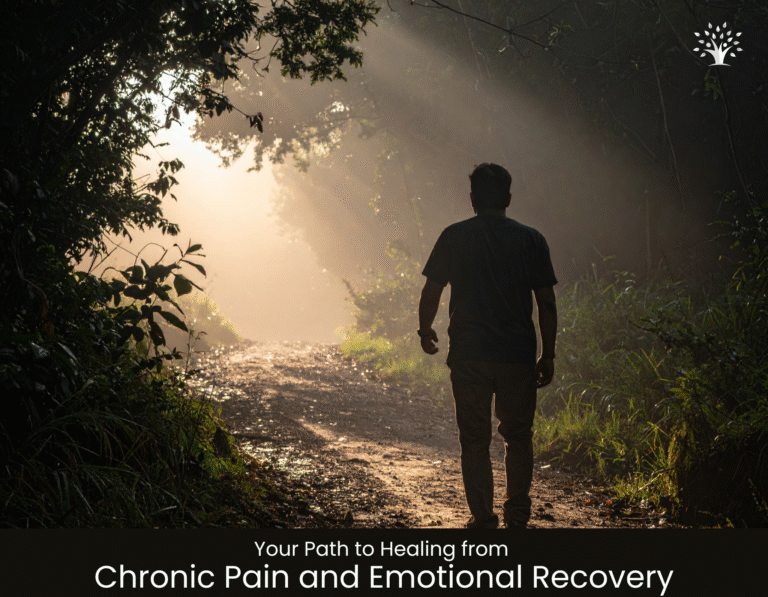
Part of My 7-Step Pain & Stress Recovery Protocol
Ask for Help
I thought I was tough. I thought I could handle it. But chronic pain will break even the strongest will. I finally asked for psychiatric and psychological help. They didn’t give me magic—just simple advice that helped me cope. That changed everything.To all the men out there reading this: we are conditioned to be tough, to bull our way through pain, to grit our teeth and power forward. But in this space—when your body is broken and your mind is overwhelmed—it’s okay to ask for help. In fact, it’s necessary. I’ll be honest: it wasn’t easy to open up and admit I couldn’t do it alone. But when I finally did, it took an enormous weight off my shoulders and gave me back my strength.
Products That Actually Helped Me These are tools I use and trust. If you’re managing pain or trying to sleep better, they may help you too. Some of these are affiliate links, meaning I may earn a commission if you purchase. This comes at no extra cost to you, and helps us keep sharing practical tools.
Epitomie Fitness Muscle Max Massage Ball: A firm therapy ball that helps break up knots and muscle spasms in the back and neck.
The Original Neck Hammock: Cervical traction device that decompresses the neck—my go-to when I feel pressure building.
Sumifun 4% Lidocaine + 1% Menthol Patches: Temporary pain-numbing patches that buy time while other meds or tools take effect.
Sleep Support Tools That Made a Difference
Osteo Cervical Pillow for Neck Pain Relief: A contoured pillow that cradles your neck for better posture and pain relief while sleeping.
Reusable Silicone Earplugs for Noise-Canceling Sleep: My #1 sleep tool. Blocks out everything when I’m traveling or trying to rest in noisy spaces.
Nature Made Magnesium Glycinate 200 mg: I don’t take this every night—but when I’m especially sore or restless, it helps relax muscles and support deep sleep. Don’t overuse it or your body may adjust.
I took what I learned from professionals and shaped it into a routine that worked for me. Everyone’s pain is different. You have to experiment, adapt, and listen to your body to figure out what helps. Take what works, adjust it, and turn it into something that fits your reality. That’s how healing starts to stick.
These aren’t theories. These are survival steps. If you’re in pain right now, try one. Just one. That’s the doorway forward. Because pain management is stress management—and both are within your reach.
How Men Can Build Resilience and Cope with Chronic Pain – LinkedIn
Coping with Chronic Pain: Good Advice Is Easy to Give but Hard to Take – Behavioral Health News
VII. Final Thoughts: Start Where You Are
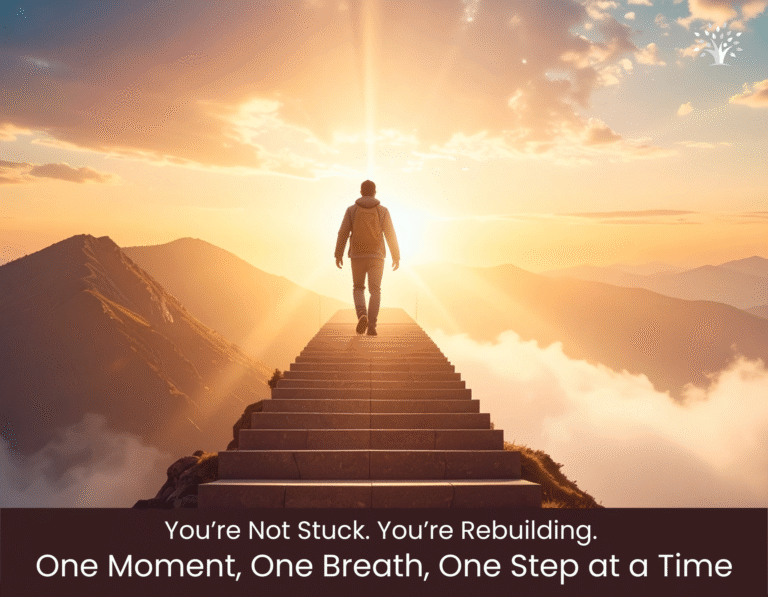
Pain can feel endless. But I’ve learned this — you don’t have to be perfect, or strong, or fast.
You just have to begin. You’re not stuck. You’re rebuilding. One moment, one breath, one step at a time.
If you’re struggling today, choose just one thing from this post: a walk, a stretch, a quiet moment, or even telling someone how you feel. That small action shifts everything.
And if this helped you even a little — please share it. Someone else is quietly suffering too.
Mijung and I built TouchCare Lifestyles to help people like us — people who want to live well, heal naturally, and never give up. You’re not alone anymore.
This blog is just the beginning of what Mijung and I hope will be a resource for recovery — practical, personal, and rooted in compassion.